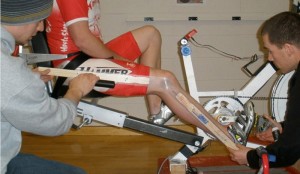
By Katie Harrington
The University of Utah’s Neuromuscular Function Lab is a gadget-enthusiast’s dream. Contraptions of all sorts sit in the large room – motors, crank wheels, fly wheels, and machines than seem to combine them all.
But what is more alluring than the contraptions themselves are the scientists who created them.
Dr. Jim Martin and Dr. Steve Elmer – both exercise physiologists – have spent their careers seeking to understand neuromuscular function within the context of repetitive – or cyclical – contractions.
“Cycling turns out to be a really good model to experiment because you can control things well or measure the things you can’t control,” said Martin, who directs the lab.
The lab performs a multitude of studies every year, most of which utilize cycling as the main experimentation model.
The lab has produced manuscripts on aging, growth and development, fatigue, cycling crank length, cycling aerodynamics, and modeling of performance – just to name a few.
“We run the gamut from maximal sprinting by well-trained cyclists to interval training by metabolic syndrome patients to facilitating physical activity during the workplace hours,” Martin said.
The lab is unique in that they study oxygen consumption and neuromuscular function inclusively, which helps to fuse biomechanics and physiology within the lab’s various studies.

Cycling Biomechanics
Ernie Rimer – one of Martin’s doctoral students – is currently conducting a study on the biomechanics of cycling. Rimer is primarily investigating how different body positions change the biomechanics of certain joints during pedaling.
“If you were to deliver 300 watts of power to the pedals, that power is ultimately generated by the muscles that span the hip, the knee, and the ankle,” Martin said. “We are able to determine how much power is being generated from each of those joints by measuring which muscles are active.”
The lab uses electromyography to measure the location of that power – a technology that senses electrical activity when a particular muscle is activated.
Rimer and Martin have also started another cycling biomechanics study that explores the connection between a person’s handlebar position and how that position affects their pedal stroke.
“When you lean on the handlebars, it turns out it affects your pedaling. When you stay light on the handlebars, that affects your pedaling in a different way,” Martin said. “We are working through exactly how that manifests itself in term of cycling biomechanics.”
The results of the study could have important implications on current cycling technique, bike fitting protocol, and ulnar nerve entrapment, Martin said.
Unique Equipment
The lab creates all of their own cycling equipment in order to design experiments and control variables optimally.
One such piece of equipment is called an eccentric cycle ergometer – a bicycle whose pedals are driven by a motor as a way to test the cyclist’s lengthening contractions.
The main goal in using this machine is to resist the pedals as efficiently as possible given that the power of the motor is much greater than the cyclist’s leg power.
Martin said the movement measured on this machine is analogous to weight lifting: a person does not get sore as they lift the weight, but rather when a person sets the weight down – known as the eccentric, or lengthening, contraction.
“We have used this machine both as a training model and as a damage model,” Martin said. “You can do this very cautiously and get a tremendous training response. Or you can do it very recklessly and get incredibly sore.”
At the end of a 7-week training period using this machine, lab participants increased their power dramatically, Martin said.
Martin has also become increasingly interested in facilitating physical activity in sedentary workplaces. The lab recently created a desk whose design incorporates pedals beneath the workspace and more efficiently supports a person’s elbows and posture.
The desks are being utilized in certain office environments for research purposes, which will give the lab insight as to whether the desks are increasing physical activity within sedentary environments.
Hands On
Steve Elmer – who got his Ph.D. under Martin – has begun taking the last fifteen years of research regarding leg neuromuscular function and applying it to the arms.
“When we think of muscular function, we think of muscles in the legs during locomotive tasks like walking, cycling, running, jumping, and so on,” Elmer said. “But locomotive tasks can also involve muscles in the upper body. If you’re an Olympic kayaker, a person with spinal cord injuries, or an elderly person, you are relying a lot on the arm muscles.”
Elmer uses a hand-cranking cycling ergometer during his studies – a contraption similar to the leg version used to study biomechanics. Both are stationary bikes used strictly to quantify work and power. What is unique to Elmer’s machine, though, is that it has the ability to go forward for traditional cycling techniques and backward for pedal resistance.
Elmer’s studies thus far have shown that when performing comparable exercise tasks, a person’s arm muscles are much weaker than their leg muscles.
“You can’t do nearly the same resistance or power outputs with the arms, especially as it relates to fatigue,” Elmer said.
The arm muscular function studies test healthy groups currently, but the goal is to eventually work with COPD patients – to strengthen upper body muscles for respiratory improvement – and spinal cord injury patients, Elmer said.
A wide range of people use the studies produced by the Neuromuscular Function Lab – from researchers to clinicians to academics to athletes and teams interested in cycling and muscle efficiency.
If you would like to participate in one of the Neuromuscular Function Lab studies, please visit www.facebook.com/neuromuscularfunction.lab or contact Jim Martin at jim.martin@utah.edu. For more on the lab, visit : http://health.utah.edu/ess/clinics/nmfl.html For a list of some of Dr. Martin’s publications, see: www.ncbi.nlm.nih.gov/pubmed/?term=james+c.+martin+utah
Katie Harrington on Google Plus








